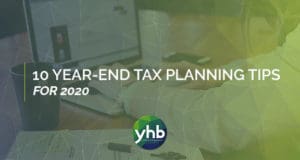 2020 has seen more than its share of uncertainty around tax planning. As the year-end approaches individuals and business owners should be reviewing their situations and talking to their accountants about opportunities to reduce or defer any tax obligations. Here are 10 key tax considerations for year-end planning for individuals:
2020 has seen more than its share of uncertainty around tax planning. As the year-end approaches individuals and business owners should be reviewing their situations and talking to their accountants about opportunities to reduce or defer any tax obligations. Here are 10 key tax considerations for year-end planning for individuals:
Evaluate Withholding
Now is a good time to double check your withholding amounts and see if there are any adjustments that need to be made. The IRS withholding calculator is a helpful tool. YHB is also happy to help ensure your withholding amounts are where they should be.
Max Out Your 401(k)
401(k) Contributions can help reduce your tax liability. Consider making additional contributions to your 401(k) plan. For 2020, the contribution limit for employees was $19,500. Employees age 50 or older can take advantage of catch-up contributions up to $6,500.
Hold Off on Mutual Fund Purchases
Purchasing Mutual Funds close to the end of the year can sometimes backfire. Yearend dividends from mutual funds held in a taxable account can increase tax liability. Before making purchases, it is always a good idea to meet with a broker to make informed decisions.
Make Charitable Contributions
Typically, there is no tax benefit for making charitable contributions unless you itemize your deductions. However, due to the CARES Act, taxpayers who do not itemized their deductions are eligible for an above-the-line charitable deduction of up to $300 for cash contributions made to qualifying organizations in 2020.
Maximize HSA Contributions
Contributions to your Health Savings Account (HSA) reduce taxable income. The contribution limits for 2020 are $3,550 for individuals and $7,100 for families.
RMD Suspended
Typically, we advise our clients to verify they have received all required minimum distributions (RMD) in order to avoid penalties. However, the Cares Act waived RMD in 2020.
Sell Stock for a Loss
Sell stock for capital losses to offset taxable capital gain income. If your losses are more than your gains, you can use up to $3,000 of those excess losses to reduce taxable income. If you have more than $3,000 in excess loss, it can be carried forward year after year to be used when needed.
Understand the Impact of the Stimulus Check
The stimulus check payments were not an advance on tax refunds and is not taxable income. The stimulus payment is, in essence, a new federal tax credit for the 2020 tax year. The payments were based on 2018 or 2019 return information. That information was used as a baseline for determining the taxpayers 2020 tax credit.
Use Your FSA Balance
Your Flexible Spending Account (FSA) allowed you to save pretax dollars to use on qualifying expenses. Typically, this balance must be used by the end of the year. Do not lose this advantage.
Meet with Your Tax Advisor
Now is a good time to meet with your tax advisor. Your advisor is able to view your specific situation and develop a strategy that is best for you. Feel free to contact YHB if you have any questions on the above tips or to start your planning today.

 Nykeya graduated from Lord Fairfax Community College with an Associate Degree in Business Administration in May 2009, graduated from George Mason University with a Bachelor’s degree in Accounting in May 2011, and earned a Master’s Degree in Accounting from George Mason University in May 2012 after a residency in London, England. Nykeya joined YHB in 2012 and became a licensed CPA in 2014. Since joining YHB, her career focus has been on the audit of employee benefit plans.
Nykeya graduated from Lord Fairfax Community College with an Associate Degree in Business Administration in May 2009, graduated from George Mason University with a Bachelor’s degree in Accounting in May 2011, and earned a Master’s Degree in Accounting from George Mason University in May 2012 after a residency in London, England. Nykeya joined YHB in 2012 and became a licensed CPA in 2014. Since joining YHB, her career focus has been on the audit of employee benefit plans.